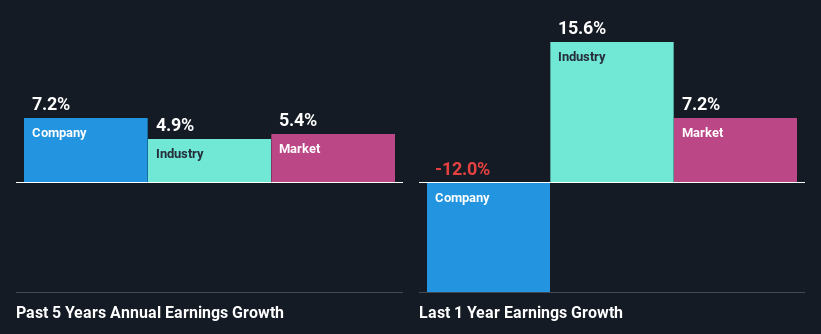Are Robust Financials Driving The Recent Rally In Bell Food Group AG's (VTX:BELL) Stock?
Bell Food Group (VTX:BELL) has had a great run on the share market with its stock up by a significant 13% over the last month. Given that the market rewards strong financials in the long-term, we wonder if that is the case in this instance. Specifically, we decided to study Bell Food Group's ROE in this article.
Return on Equity or ROE is a test of how effectively a company is growing its value and managing investors’ money. In short, ROE shows the profit each dollar generates with respect to its shareholder investments.
See our latest analysis for Bell Food Group
How To Calculate Return On Equity?
Return on equity can be calculated by using the formula:
Return on Equity = Net Profit (from continuing operations) ÷ Shareholders' Equity
So, based on the above formula, the ROE for Bell Food Group is:
8.5% = CHF118m ÷ CHF1.4b (Based on the trailing twelve months to June 2022).
The 'return' is the yearly profit. So, this means that for every CHF1 of its shareholder's investments, the company generates a profit of CHF0.09.
What Has ROE Got To Do With Earnings Growth?
So far, we've learned that ROE is a measure of a company's profitability. Based on how much of its profits the company chooses to reinvest or "retain", we are then able to evaluate a company's future ability to generate profits. Assuming everything else remains unchanged, the higher the ROE and profit retention, the higher the growth rate of a company compared to companies that don't necessarily bear these characteristics.
Bell Food Group's Earnings Growth And 8.5% ROE
To begin with, Bell Food Group seems to have a respectable ROE. Even so, when compared with the average industry ROE of 15%, we aren't very excited. However, the moderate 7.2% net income growth seen by Bell Food Group over the past five years is definitely a positive. We reckon that there could be other factors at play here. For instance, the company has a low payout ratio or is being managed efficiently. Bear in mind, the company does have a respectable level of ROE. It is just that the industry ROE is higher. So this also does lend some color to the fairly high earnings growth seen by the company.
Next, on comparing with the industry net income growth, we found that Bell Food Group's growth is quite high when compared to the industry average growth of 4.9% in the same period, which is great to see.
The basis for attaching value to a company is, to a great extent, tied to its earnings growth. What investors need to determine next is if the expected earnings growth, or the lack of it, is already built into the share price. This then helps them determine if the stock is placed for a bright or bleak future. If you're wondering about Bell Food Group's's valuation, check out this gauge of its price-to-earnings ratio, as compared to its industry.
Is Bell Food Group Efficiently Re-investing Its Profits?
Bell Food Group has a healthy combination of a moderate three-year median payout ratio of 36% (or a retention ratio of 64%) and a respectable amount of growth in earnings as we saw above, meaning that the company has been making efficient use of its profits.
Moreover, Bell Food Group is determined to keep sharing its profits with shareholders which we infer from its long history of paying a dividend for at least ten years. Based on the latest analysts' estimates, we found that the company's future payout ratio over the next three years is expected to hold steady at 35%. Accordingly, forecasts suggest that Bell Food Group's future ROE will be 7.8% which is again, similar to the current ROE.
Summary
Overall, we are quite pleased with Bell Food Group's performance. Particularly, we like that the company is reinvesting heavily into its business at a moderate rate of return. Unsurprisingly, this has led to an impressive earnings growth. That being so, a study of the latest analyst forecasts show that the company is expected to see a slowdown in its future earnings growth. Are these analysts expectations based on the broad expectations for the industry, or on the company's fundamentals? Click here to be taken to our analyst's forecasts page for the company.
Have feedback on this article? Concerned about the content? Get in touch with us directly. Alternatively, email editorial-team (at) simplywallst.com.
This article by Simply Wall St is general in nature. We provide commentary based on historical data and analyst forecasts only using an unbiased methodology and our articles are not intended to be financial advice. It does not constitute a recommendation to buy or sell any stock, and does not take account of your objectives, or your financial situation. We aim to bring you long-term focused analysis driven by fundamental data. Note that our analysis may not factor in the latest price-sensitive company announcements or qualitative material. Simply Wall St has no position in any stocks mentioned.
Join A Paid User Research Session
You’ll receive a US$30 Amazon Gift card for 1 hour of your time while helping us build better investing tools for the individual investors like yourself. Sign up here

 Yahoo Finance
Yahoo Finance 
